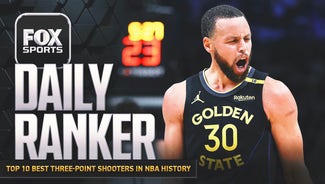
NBA season preview: Can Hornets make playoffs without Kidd-Gilchrist?
There's a chance that the most impactful news concerning the 2015-16 Charlotte Hornets' playoff hopes is already in the rearview mirror. When starting forward Michael Kidd-Gilchrist suffered a torn labrum in his right shoulder in a preseason clash with the Orlando Magic, the Hornets immediately lost one of the NBA's brightest under-25 standouts in the league.
Kidd-Gilchrist undergoing season-ending surgery not only affects the Hornets' starting rotation, but calls into question their identity under coach Steve Clifford. Charlotte is a defensive-minded franchise, and if the team's best wing defender — and arguably its best player — is out of commission, can that strength still carry it back to the playoffs? How the Hornets address Kidd-Gilchrist's absence, their shooting issues and find ways to make a variety of new pieces fit will determine their standing in a down, but improving Eastern Conference.
Lance Stephenson, Gerald Henderson, Noah Vonleh, Mo Williams and Bismarck Biyombo are gone. In their place, the team brought in Nic Batum, Jeremy Lamb, Jeremy Lin, Spencer Hawes and Tyler Hansbrough, plus first-round draft pick Frank Kaminsky. Stephenson was the primary problem for the league's worst perimeter shooting team last season, but he's now in Los Angeles and Clifford has spoken openly how he's hoping the new additions can help provide some sort of 3-point threat.
The reality of the matter is that, on paper, the East looks more formidable, and if the Hornets can not balance the Kidd-Gilchrist injury with improved offensive efficiency then they are destined to miss the playoffs for the 10th time in 12 seasons.
Nic Batum became a consistent contributor with the Portland Trail Blazers, overshadowed by the Damian Lillard-LaMarcus Aldridge duo but a more-than-capable starting option. Approaching his 27th birthday, the 6-foot-8 forward is on the verge of free agency after posting seven consecutive quality seasons (three-plus win shares). The Hornets acquired Batum in a June trade for Henderson and Vonleh, and he'll now occupy an even bigger role given this team's needs.
Batum battled a nagging wrist injury and went through an offensive slump last season, particularly in the shooting department, but he should be an upgrade offensively from Stephenson and he has the ability to do just about everything on the floor well. He's a 36.3 percent outside shooter, solid rebounder and just posted his career's best defensive rating.
Setting aside last season's injury setbacks, Batum averaged 13 points and 5.4 rebounds at a 15.9 PER in the previous five seasons — similar numbers to the likes of Denver's Danillo Gallinari over that stretch. He's a bona fide NBA starter. Can he, along with Lamb and P.J. Hairston, add a different dimension to the perimeter while maintaining a sufficient balance on defense?
If Batum is healthy and playing up to his potential, he could be the Hornets' best player this season.
The Hornets made the (highly controversial) decision to pass on home-state product Justise Winslow, the hyper-athletic Duke wing who dominated the NCAA Tournament, to draft Kaminsky, the versatile Wisconsin 7-footer with the ability to stretch the floor. Kaminsky enjoyed a decent Summer League and preseason, capping it off with a 19-point effort against Indiana, but where he fits into the frontcourt rotation remains to be seen.
The Hornets feature Jefferson, the team's highest-paid player one season removed from a third-team All-NBA nod, Cody Zeller, Marvin Williams, Tyler Hansbrough and Spencer Hawes. That isn't an insurmountable depth chart if Kaminsky can avoid the rookie wall, and his playing time will likely rely, first and foremost, on how well he picks up Clifford's defensive rotations and principles.
Kaminsky can add a dimension to this frontcourt that was lost when Josh McRoberts left in free agency. Now it's a matter of catching up to speed. As with many rookies, that could take time.
5.9: Al Jefferson's turnover percentage was the second-best mark in the NBA behind Anthony Morrow, a spot-up shooter who does not have to deal with constant double-teams in the post. In fact, thanks to Jefferson and point guard Kemba Walker, the Hornets finished with best turnover rate in NBA (11.2), directly ahead of three playoff teams in the Clippers, Mavericks and Raptors.
31.8: The Hornets' shooting woes are well-documented. Their 31.8 3-point percentage not only ranked dead last in the NBA, but it was a 33-point drop from the 2013-14 season.
79.3: Defensive rebounding has become Clifford's calling card: The Hornets have led the league in defensive rebounding rate in each of the past two seasons.
... the Hornets can off-set their pending drop-off defensively with dramatic offensive improvement.
It's not just the Kidd-Gilchrist injury, either. Biyombo was a high-quality backup rim protector and, other than Batum, the team wasn't exactly concerned with adding defensive help in the offseason. Clifford has proven more than capable of coaching quality defense, though, so the question is if the team can take leaps forward with additional shooting, Stephenson's departure and a more versatile frontcourt.
With the way this team is built, if it shoots anywhere close to last season's paltry marks, it's not going anywhere. Walker and Jefferson are still the twin engines that this team relies on, but career years out of the likes of Batum, Zeller and/or Lamb might be necessary.
Until that happens, there's room for skepticism as other East teams like the Heat, Magic and Pacers — teams that joined the Hornets outside of the playoff picture last season — return to full health and look to take significant steps forward. It's an uphill battle at this point.
PREDICTION: 36-46, Miss Playoffs




